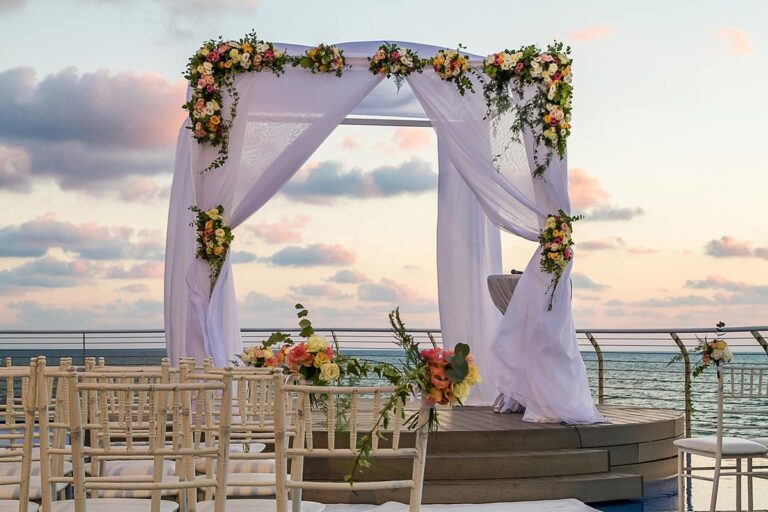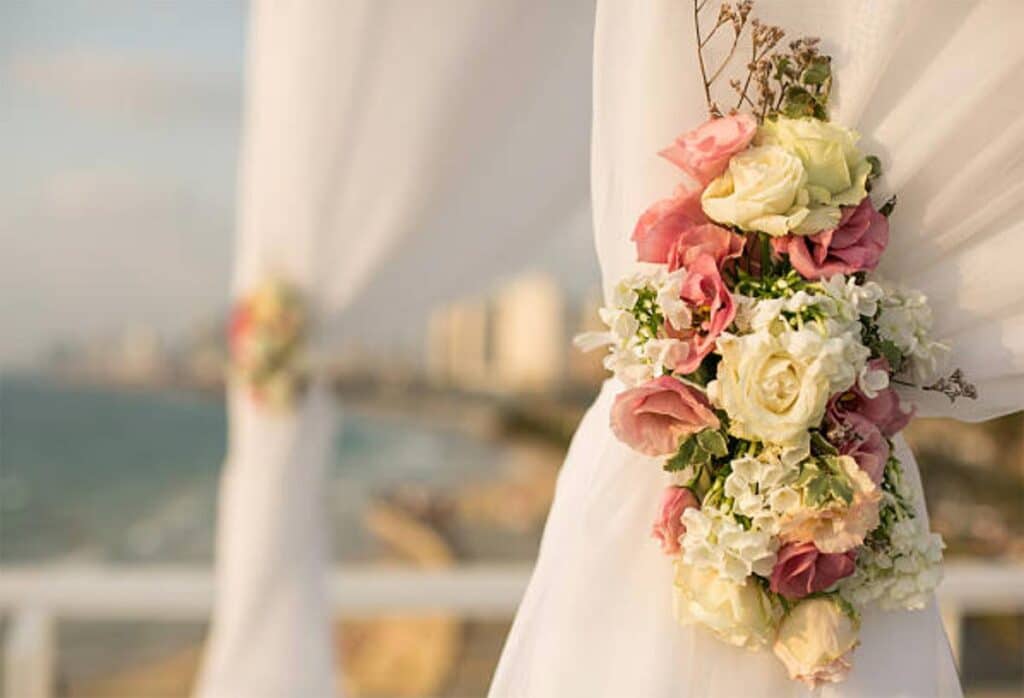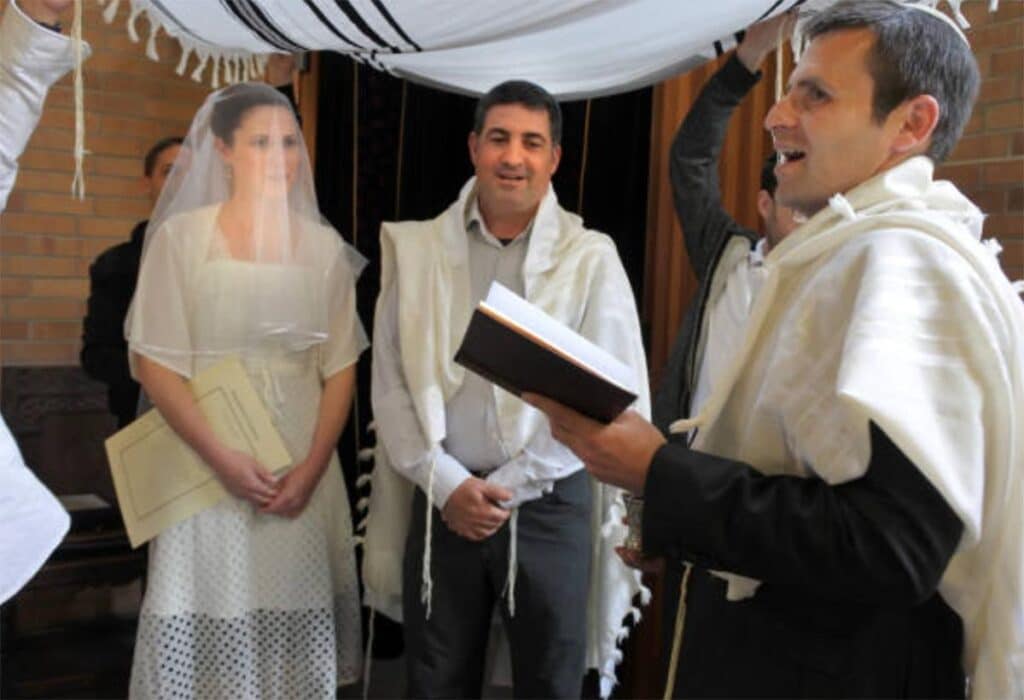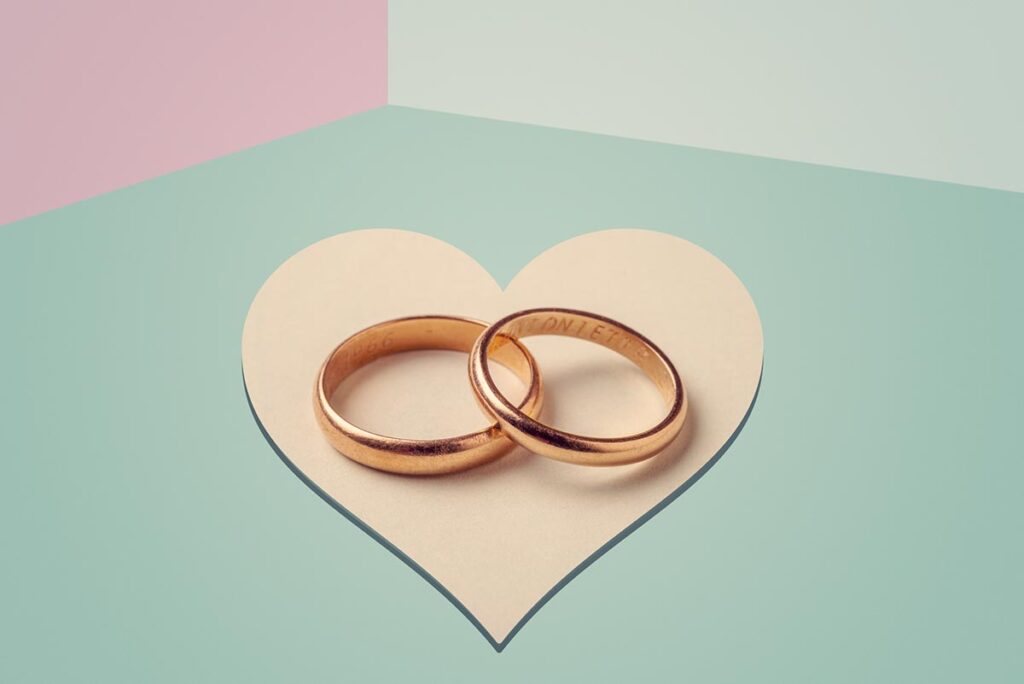
Jewish weddings are a unique blend of tradition and celebration, and it’s easy to get lost if you’re not familiar with the rituals and their meanings. Whether you’re stepping under the huppah as the bride or groom or simply attending as a guest, perhaps for the first time, here’s a guide to the traditions and rituals that make up a Jewish wedding, and what they mean.
With this ultimate guide, you can fully immerse yourself in the experience, appreciating every moment from the Shabbat Kalla to Sheva Brachot. Let’s start with the pre-wedding rituals.
Read more: 5 surprising differences between Israeli and American weddings
Ashkenazi pre-wedding rituals

Jewish weddings begin days before the main ceremony under the huppah. There are many pre-wedding rituals leading up to the celebration, with different traditions in Ashekazi and Sephardic communities.
In Ashkenazi communities, the bride and groom observe separate pre-wedding rituals. The bride is celebrated with a Shabbat Kalla on the Shabbat preceding the wedding. This is a time for the bride to spend quality time with her family and close female friends. Typically a low-key gathering at home, there are no specific customs or ceremonies for a Shabbat Kalla.
On the same day, the groom is honored with an aufruf (which means “calling up” in Yiddish) in synagogue. At this ceremony, he is called up to the Torah for an aliyah (reciting blessings before and after the Torah reading). In Reform and Conservative congregations, both the bride and groom are typically called to the Torah.
In Ashkenazi circles, many couples observe the custom of not seeing each other during the week leading up to the wedding. Some couples even refrain from phone calls and texting. There are various reasons given for this tradition — Rabbi Binyamin Forst believes that it gives the bride and groom an opportunity to “be alone and to reflect upon the profound changes that are about to take place in their lives.” Although this custom isn’t found in classical Jewish texts, it is a widespread practice today.
Sephardic pre-wedding rituals
In Sephardic communities, before the big day, the bride and groom take part in a “henna” ceremony. Their families and friends join together at this celebration, where hands are adorned with beautiful henna designs.
While some opt for this to be an intimate gathering at home, others host events that rival the main wedding with lavish decorations, music, dancing, and ornate costumes. According to Mizrahi Jewish tradition, henna protects the couple from the evil eye and blesses them with good luck, good health, and fertility.
In both Ashkenazi and Sephardic communities, other pre-wedding rituals include the bride and groom immersing separately in a mikveh, a ritual bath symbolizing purification or spiritual renewal. This immersion marks their transition from singlehood to marriage, preparing them spiritually and physically.
Additionally, the couple traditionally fasts on their wedding day, reminiscent of the serious nature of Yom Kippur. This fast represents their desire for atonement, allowing them to begin their married life with a clean slate. It also ensures that the bride and groom are clear-headed and sober, ensuring the wedding is valid and their judgment was not distorted. The fast starts at dawn and ends with a shared meal after the huppah ceremony.
Initial ceremony rituals
The wedding festivities begin with the Kabbalat Panim, a pre-wedding reception where the bride and groom separately receive guests. Close family, friends, and sometimes community members attend, offering personal blessings and wishes before the ceremony.
During this time, the ketubah, or marriage contract, is signed. In Orthodox traditions, it is signed by the groom and two male witnesses. However, in many Reform and Conservative communities, both the bride and groom sign the Ketubah. This formalizes the couple’s commitment in both legal and spiritual terms, setting the stage for the rest of the ceremony.

In Ashkenazi tradition, the groom may choose to host a Tisch (Yiddish for “table”), where the groom and his male family and friends gather to sing, share words of Torah, and most likely drink a little whiskey as well.
Meanwhile, the bride sits at the kisei kalla or bride’s chair. Drawing from Jewish mystical tradition, it’s believed that the gates of heaven are open to the bride’s prayers on her wedding day, and she typically offers blessings to the guests. There is typically joyful Jewish music playing and lots of singing and dancing surrounding the bride during this time.
Bedeken (Veiling)
In the Ashkenazi tradition, just before the wedding ceremony starts, the groom veils the bride at a ceremony called the bedeken. Traditionally, the guests gather around the bride, singing and dancing, as they wait for the groom to walk over after signing the ketubah. The bride wears this veil until the end of the wedding ceremony.
One prevalent interpretation of this ritual is rooted in the Biblical story where Jacob unknowingly married Leah instead of Rachel due to a veiled face. By placing the veil over the bride’s face himself, the groom symbolically ensures he is marrying the right person. Another interpretation is that, by veiling the bride, the groom signals that he is marrying her not for her physical appearance, but for his deep commitment to her as a person.
Yet another explanation is rooted in the Torah portion, Hayyei Sarah. When Rebecca sees her future husband, Isaac, in the distance, she covers herself with a veil (Beresheet/Genesis 24:65). It’s this gesture that Jewish brides replicate at every wedding. At the bedeken, it is customary to bless the bride with the same blessing that was bestowed upon Rebecca: “O sister! May you grow into thousands of myriads.”
Huppah (Wedding ceremony)

The heart of the Jewish wedding is the ceremony under the huppah, a beautiful canopy supported by four poles. This open structure draws inspiration from the tent of Abraham and Sarah, symbolizing a home where all are welcomed with the same warmth that Abraham and Sarah extended to their guests.
As the bride approaches the huppah, she performs the “hakafot” by circling the groom seven times. “Hakafot” translates to “circling” or “going around” in Hebrew.
Jewish tradition offers several possible meanings of this ritual: the number seven, which holds a significant place in Judaism, signifies completion, sanctity and wholeness. These themes echo throughout the wedding ceremony. These seven hakafot could also reflect the seven days of creation, symbolizing the couple’s creation of their new shared life and the intertwining of their souls.
This is when the wedding truly begins. The wedding ceremony itself consists of two parts: the Erusin (betrothal) and the Nissuin (marriage). During the Erusin, the couple recites two blessings: one over wine and a second blessing that sanctifies the act of marriage under Jewish law, expressing their commitment to one another. Nissuin, which follows, is when they officially become a married couple.
Historically, there was a gap of several months between these two stages. Today, they are conducted together, forming a marriage of kedusha or a sacred union. Let’s delve into these two stages of the wedding ceremony.
Birkat Erusin (Engagement Blessings)

Traditionally, the Erusin includes two blessings and the ring ceremony. In both Ashkenazi and Sephardic communities, the rabbi recites Birkat Erusin (betrothal blessings) over a cup of wine, and the bride and groom take a sip to show their acceptance of the engagement.
Following the blessing, the groom places a ring on the bride’s index finger and recites: “Harei at m’kudeshet li, b’taba’at zo, k’dat Moshe v’yisrael” (“Behold, by this ring you are consecrated to me as my wife according to the laws of Moses and Israel”).
In Sephardic communities, the bride then gives the groom a tallit (prayer shawl), and either the groom or both recite the Shehecheyanu, a blessing for new experiences. This is followed by the reading of the ketubah (marriage contract), which serves as a transition from Erusin to Nissuin. Typically, either the full ketubah or a summary is read.
Sheva Brachot (Seven Blessings)
After the betrothal blessings and ring ceremony comes the actual marriage! The Nissuin portion of the ceremony involves the Sheva Brachot (Seven Blessings), recited over a second cup of wine. Typically, these blessings are recited by various individuals close to the couple, chosen for this honor.
The Sheva Brachot celebrate the union and wish the couple joy, love, companionship, and peace in their shared journey. While the text of these blessings is consistent for Sephardic and Ashkenazi Jews, the two communities have different melodies for reciting them. Beyond the wedding day, the Sheva Brachot are also recited at festive meals throughout the following week.
Breaking of the Glass

At this point, it’s time for a little drama! After the seven blessings are recited, a glass is placed on the floor and the groom steps on it and breaks it. This act symbolizes the fragility of life, and commemorates the destruction of the Temple in Jerusalem. Embedded within this ritual is also a message from Talmudic tales (Brachot 30b-31a): to temper overwhelming joy, recalling instances where rabbis sought to moderate excessive jubilation at weddings.
Once the groom breaks the glass, the guests shout “Mazel Tov!” If you’re attending a wedding in Israel, and in some communities, the guests rush to the huppah to celebrate the bride and groom and give them personal congratulations. According to the Talmud (Brachot 6b), bringing joy to the bride and groom on their wedding day isn’t just a kind gesture — it’s a mitzvah.
Yichud (Seclusion)
Following the ceremony, the newlyweds take a moment away from the crowd in a practice known as Yichud, which translates to “seclusion.”
While some view standing under the huppah as a form of Yichud, others believe that the marriage is not solidified until this intimate moment. In Ashkenazi tradition, the couple usually enters into seclusion immediately post-huppah, with a few witnesses present. However, some Sephardic communities do not follow the Yichud practice.
Besides offering the couple their first private moments as newlyweds, this time is also a chance to eat and drink if they have observed the day’s fast. Many couples ask for a serving of the reception meal to be brought to the room so they can eat in peace before being whisked off to the dance floor.
Wedding reception
This is where the party really comes alive! The reception is a lively blend of dancing, music, and a seudat mitzvah — a festive meal marking the completion of a mitzvah. It’s a joyful celebration that can last for hours or even days, depending on the community’s customs.
Each Jewish community boasts its unique dances. However, a few dances you might see throughout the wedding reception are the horah, the Yemenite step, and raising the bride and groom up on chairs.
Modern traditions
While rooted in deep-seated customs, many traditional Jewish weddings today incorporate contemporary elements. A notable modern addition is the signing of a Halachic Prenup. In Jewish marriage laws, a wife needs a “Get,” a divorce document from her husband to dissolve the marriage.
Unfortunately, some women, known as agunot, are held in undesired marriages by their spouses who withhold this document. To prevent this situation and to make a stand against forced marriages, many couples now sign a document before marrying. This ensures that women are not held in marriages they no longer wish to be a part of.
With the close of the reception and festive meals throughout the following week, the union is celebrated, and the couple embarks on their new journey together. Whatever your role — be it a guest or the ones tying the knot — understanding these rituals adds layers of depth and meaning to the joyous occasion. Mazel tov!
Originally Published Aug 22, 2023 12:28PM EDT
